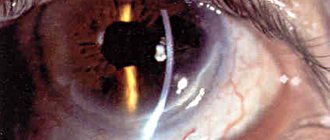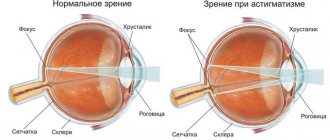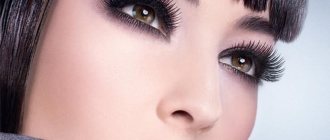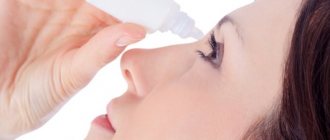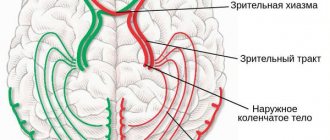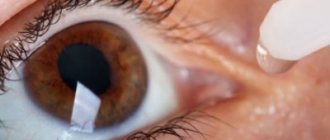Palming is a set of exercises to relax the eyes. Today, problems such as visual fatigue and fatigue often accompany human life. If left untreated, vision may deteriorate. Palming is considered one of the simplest non-traditional methods for restoring vision. Let's take a closer look at it.
This method was developed by Dr. William Bates. He believed that refractive pathologies are provoked by tension in the visual organs, therefore, relaxing the eyes will help avoid a number of vision problems.
How to do eye palming according to Zhdanov?
Before palming, rub your palms together vigorously to warm them up. If you are palming in hot weather, the heat may cause a feeling of discomfort; in this case, it is better to briefly immerse your hands in cold water before palming. When performing the exercises, your palms should rest on your cheekbones and your fingers should rest on your forehead.
The palms are placed in such a way that not the slightest ray of light reaches the eyes. This way you can achieve maximum eye relaxation.
Palming can be performed in a sitting position:
- During palming, the neck and spine should be in one straight line, the body should be positioned in such a way that it achieves maximum relaxation.
- Place your elbows on the table or on your knees.
- The wrists and fingers are relaxed.
Is it possible to achieve significant results?
The goal of Bates exercises is to improve visual acuity by training the eye muscles. You can make a somewhat rough comparison with training in the gym. If we regularly train our body, we get results. When we give up physical activity, our muscles begin to decrepit and tone is lost.
If we constantly look at the monitor, only certain muscle groups are under tension, working in different modes, allowing our eyes to work differently, we train other muscle groups.
At the same time, it is worth clearly understanding that it is 100% impossible to restore vision in case of advanced myopia with vision of -6.0. If you perform gymnastics correctly for this pathology, you can improve the quality of vision by 1-2 diopters.
In every sport, including for vision restoration, systematicity and dosage are important. Maximum weight and exhausting training will lead to exhaustion. The same principle applies when practicing according to the Bates method.
But it is worth remembering that the Bates method is not a panacea for all eye problems; it can be safely recommended in the initial stages of myopia and farsightedness and for prevention if work involves a lot of eye strain.
Palming technique
Preparation
- Close your eyes.
- Place your palms, bent into a cup shape, over the area around the eyes so that the base of the palm touches the nose.
- Place the first phalanges of the little fingers on top of each other, crossing them on the bridge of the nose at an angle of 90°, and cross the fingers on the forehead.
- Palms do not touch eyes.
Performance
- When performing palming, you should experience complete comfort, coziness and warmth.
- Choose a convenient time and place to do the exercises so that no one distracts or disturbs you.
- Try to relax, relieve tension in the muscles of your face, shoulders, neck and other parts of the body.
- At this time, you can listen to classical music, let your thoughts soar freely, think about pleasant things.
- Put away unpleasant thoughts and promise to deal with them later.
Completion
- When finishing palming, removing your hands from your face, do not open your eyes immediately - wait a few seconds, and then open them.
- Everyone determines the required duration of the exercise individually, 4 minutes is the minimum, 5 minutes is the permissible optimal time.
Bates gymnastics for the eyes
Since Bates paid great attention to mental relaxation in his methodology, it is important to accompany each exercise with a full breathing cycle, that is, deep inhalation and exhalation.
We have collected basic exercises for you that will benefit your vision.
Palming
The first thing that Bates eye gymnastics should begin with is the “palming” exercise, which is recommended for all people with increased visual stress. The exercise is performed as follows: you need to take a comfortable position and close your eyes with your hands, so that your fingers are on your forehead and your palms completely cover your eyes.
Make sure that no light penetrates through your palms - your eyes should remain in complete darkness. Your palms should be warm, this will also warm your eyes, which will promote greater relaxation. Do not put pressure on your eyeballs, keep your palms slightly raised.
The exercise should be performed for 3-5 minutes until there is an even black field in front of your eyes, without any light spots or dots. If possible, try to relax your whole body, watch your breathing - it should be even and calm.
Ophthalmologists recommend performing this exercise several times a day, especially if you work at a computer or with documents. Palming relaxes the eye muscles well and reduces visual strain.
Sign up for a free vision test
There are no restrictions for palming. You can do the exercise as many times as you like. But before exercising, you should wash your hands, otherwise you risk getting an infection in your eyes.
Eye exercises
After palming, you can begin the main exercises:
1. Move your gaze up and down several times. Eye movements should be smooth and slow. This exercise is more of a warm-up exercise.
2. Continue moving your eyes, but now from right to left.
3. "Diagonals". Draw diagonal lines with your eyes. For example, look at the upper left corner, and then smoothly move your gaze to the lower right corner. During the exercise, use your imagination - you don’t just need to move your gaze, but imagine how you draw these lines. Repeat the exercise several times, then blink for 15 seconds.
4. "Rectangle". The exercise is based on the same principle: you “draw” a rectangle with your gaze. Having completed the first rectangle, start the second, but in the opposite direction. After the exercise, blink for 10-15 seconds.
5. "Dial". Imagine that your face is a watch dial; the center with arrows is located on the bridge of your nose. Move your gaze along imaginary numbers - 12 o'clock, 3 o'clock, 6 o'clock and 9 o'clock. Repeat several times, then blink and do the exercise in the opposite direction. You need to hold your gaze on each number; movements should be smooth and unhurried.
6. “Snake”. Draw a wavy line with your gaze from the lower right corner to the lower left, then blink and repeat the exercise in the other direction. Do the “snake” several times.
7. "Infinity" or "Eight". You need to draw an infinity sign or a figure eight lying on its side with your eyes. Start in the upper right corner and move your gaze smoothly, while imagining the figure you are drawing. Blink and do the exercise in the opposite direction, that is, starting from the upper left corner.
8. "Spiral". Draw a spiral from the center point to the outermost circle. Make smooth and slow movements. Complete the exercise when the last circle passes through your fields of vision.
9. "Coils". Imagine that there is a vertical pipe in front of you. Your task is to “wrap” it with an imaginary rope using your eyes. Make five turns in one direction and stop. Blink and continue “twisting” the pipe in the other direction, also limit yourself to five turns.
10. "Globe". The last exercise will help relax the eye muscles after training. Imagine that there is a globe in front of you. Mentally unwind it, focusing your gaze on the equator. Slowly follow the line of the equator with your eyes following the movements of the globe.
Bates also recommended combining your exercises with breathing exercises. In his opinion, this was the only way to relieve mental stress, which was the cause of visual disturbances.
Be careful! Ophthalmologists do not recommend frequent repetitions of these exercises. The complex should be performed no more than three times a day, although experts say that once a day will be enough to train and relax the eyes.
Sign up for a free vision test
How often should I do it?
Palming should be performed daily, repeating 3-5 times during the day, or better yet, more often. You can visualize while doing the exercises. Visualization is also an effective exercise, since any mental activity can find a corresponding physical manifestation. When you look “mentally”, the eyes react in a similar way, however, the reaction of the eyes is more pronounced than the muscles of the hand; the eyes are closely connected with the brain.
For some, prolonged palming promotes a greater degree of relaxation and allows them to see a darker shade of black. Others, on the contrary, can successfully perform palming for a short time, after which they experience tension.
Palming should be performed at every opportunity. Closing your eyes for a few seconds and covering them with your palms helps keep your eyes alert. In cases where palming with both hands is inconvenient, you can cover one eye or simply close your eyes as if you are dozing.
Eye muscles
But let's start the story with the structure of the eyes. Each of them has six muscles responsible for movement. Thanks to them, the eyes are turned and a round shape is made. They are pulled out and seen near and far.
Gymnastics will help cope with overstrain, both mental and physical. For those who constantly sit at the computer, it is not difficult to notice how their eyes stretch out. Within a few years, if nothing is done, the muscles will forget how to relax, after which myopia soon sets in.
Therefore, in order not to wear thick glasses, because of which (as many are sure), vision deteriorates even more, it is worth regularly learning how to do eye palming. How to do it? Very simple.
A basic exercise involves covering your eyes with your palms for a few minutes. As a result, they relax and vision is gradually restored.
Visualization of "blackness"
The quality of darkness that appears when palming is an indicator of the condition of your vision. Scientists have found that blackness in the field of vision develops independently and improves vision. You can experiment with “visualizing blackness” while palming; this technique can be very effective.
The object of visualization can be any black objects that you can think of and imagine how they quickly change each other. You can scroll through the letters of the alphabet, but the font must be black. When you reach the letter “I,” you need to compare its blackness with the blackness surrounding your field of vision. If the letter has a blacker color, imagine that it blends into the surrounding background. This process is repeated several times until the blackness becomes intense.
Practical exercises for vision training
Turn towards the bright sun and close your eyes. Make several turns of the body and head; if your eyes are accustomed to the brightness when closed, slightly open one eyelid, directing your gaze downward. Do the same with the second eyelid. If you feel tension in your eyes, blink. This gymnastics must be done carefully.
Find a place where bright sun meets shade. Stand so that one foot is on the sunny side, the other on the shady side. With your eyes closed, make slow turns of your body so that your face is either in the shade or in the sun.
When performing this practice, it is important to focus on the process; you can silently pronounce the following words “day, night.” Gymnastics are carried out until the eyes calmly perceive the changes.
The previous exercise can be made a little more complicated. If your eyes react normally to changes in lighting, you can try to open one eye and cover the other with your palm. As you continue to make turns, look at the floor and blink frequently; finally, raise your head and, still blinking, look at the sun. Do the same movements with the other eye. When finishing your practice, do a long period of palming.
These exercises can be done in sunlight or using a lamp.
The result obtained from the exercise
If palming is successful, it is one of the best ways to relax the eyes and all other senses. This method allows you to achieve complete relaxation, which persists after opening your eyes. At the same time, a person’s vision improves for a long time, pain in the eyes decreases for a long time, headaches disappear, as well as pain in other parts of the body.
Such cases are rare, but they do occur. With little relaxation, a significant part of it is lost when a person opens his eyes, and the small part that is preserved is retained for a short time.
Dynamic relaxation
Indian professor R.S. Agarwala studied Bates' theory and combined it with ancient practices of India. The exercises are performed with an OM card, which is a drawing with an image in.
- The first option for performing gymnastics with an OM card: direct your gaze to the center of the picture, find the smallest and clearest detail. Then slowly begin to look at the entire drawing, thinking that each element you are looking at is the blackest one. Do gymnastics 3 times. At the end, you will notice that the entire sign appears darker. The distance from the eyes to the map can be from 30 cm to 3 meters.
- Second option. Find the broken lines in the picture and move your gaze along the segments, moving not only your eyes, but also your head. Note that each subsequent segment is darker than the previous ones. Don't forget to blink smoothly.
Do the same exercises with the line outlining the entire drawing. These exercises are useful after glaucoma surgery.
Palming for eyes video. Zhdanov:
In the case when palming is not carried out very well, you can save only part of what has been achieved and for a short time. But a small degree of relaxation is also useful, since it allows you to achieve a greater degree of relaxation of the eyes.
By performing palming every day and several times, we will be able to hone this practice, and over time we will achieve complete relaxation of the muscles of the eyeball and see a rich black color when performing palming. And together (during palming) or after it, you can perform eye exercises.
Dear readers and guests of the blog about methods of being healthy vahe-zdorovye.ru, leave your comments and share your experience of performing this amazing and simple exercise to relax our eyes. Love and Gratitude!
William Bates' method for restoring vision: what is the essence
At the beginning of the last century, ophthalmologist William Bates presented his own theory about the causes of the development of visual impairments and developed his own method for restoring one hundred percent vision.
The bottom line was this: Bates noticed that even vision correction does not stop the development of myopia, farsightedness, astigmatism and other diseases. Moreover, according to the doctor, vision with glasses will continue to rapidly deteriorate.
Based on his own suspicions, observations and a number of studies, Bates came up with the following theory: visual acuity directly depends on six eye muscles - transverse and longitudinal - and their tone. According to Bates, it is under the influence of these muscles that the eye changes its shape, and they are also responsible for focusing at different distances.
The doctor was sure that in a normal state the muscles are relaxed and the eye has a spherical shape. When a person examines objects close up, his transverse muscles tense, his longitudinal muscles, on the contrary, relax, and the eye stretches, taking on an oval shape. And vice versa - while peering into the distance, a person relaxes the transverse muscles. This way the eye returns to its spherical shape.
This convinced Bates that the cause of myopia, hypermetropia and other disorders was excessive strain on the transverse and longitudinal muscles, respectively. At the same time, Bates assumed that the condition of the eyes was affected by general mental stress. Based on his theory, the ophthalmologist developed his own method for restoring vision, which involved relaxing overstrained eye muscles and relieving mental stress.
At the same time, Bates insisted on incomplete vision correction. That is, the glasses assigned to a person in optical power should have exceeded vision by only 1-1.5 diopters. And ideally, the correction should have been abandoned in principle.
Bates assured that his set of exercises would help completely restore vision in a matter of weeks.
Is Bates' theory true?
The theory presented by the ophthalmologist fundamentally contradicts the basics of evidence-based medicine, according to which visual impairment is caused by disproportionate refraction (refractive power) or the anteroposterior axis (length) of the eye.
Bates's contemporaries were confident in the ineffectiveness of the method developed by the ophthalmologist. Alas, modern medicine has only confirmed the fact that the extraocular muscles do not have a critical effect on visual acuity. However, Bates’s gymnastics cannot be called completely useless.
Sign up for a free vision test
Many exercises for restoring vision are based on the principle of relaxing the extraocular muscles. You should not expect that such a charge will return one hundred percent vision. However, your overall eye health may improve. But it is important to follow the correct exercise technique and perform only vision-safe workouts.
Palming and solarization for strabismus
Strabismus not only affects the quality of vision, it is also a very significant external defect. In such cases, it is highly advisable to resort to special exercises, but only after consultation with an ophthalmologist.
For strabismus, the methods of palming and solarization with a candle, described above, are especially effective. According to Zhdanov, “pleasant memories” help achieve a double effect when palming, therefore it is extremely important to think or dream about something good while sitting with your eyes closed.
Let's sum it up
Now you know about one of the techniques for restoring vision - palming according to Zhdanov. It is not difficult to do, it takes very little time, and if you follow it regularly, the result will not be long in coming. When performing the technique, do not forget about the spiritual component - positive thoughts will speed up the healing process. In addition, it is not without reason that they say that all thoughts are material - so why not kill two birds with one stone?
Health does not get better every year, because the sooner you take care of its condition, the better it will be for you. Refusal of alcohol, a healthy lifestyle, regular exercise, a focus on proper nutrition (according to Zhdanov, we are talking about separate meals) - all this will make you a happy, healthy and full of energy person!

